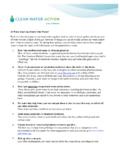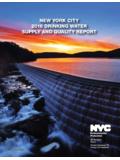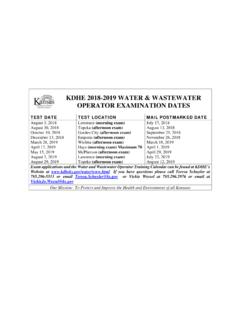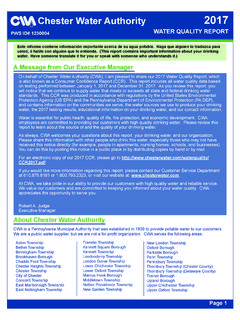Transcription of OPPORTUNITIES TO PROTECT DRINKING WATER SOURCES …
1 OPPORTUNITIES TO PROTECT DRINKING WATER . SOURCES AND advance watershed goals . THROUGH THE CLEAN WATER ACT. A Toolkit for State, Interstate, Tribal and Federal WATER Program Managers November 2014. Acronyms ACWA Association of Clean WATER Administrators ASDWA Association of State DRINKING WATER Administrators AWQC Ambient WATER Quality Criteria BMP Best Management Practice CFR Code of Federal Regulations CAFO Concentrated Animal Feeding Operation CSO Combined Sewer Overflow CWA Clean WATER Act CWSRF Clean WATER State Revolving Fund DWSRF DRINKING WATER State Revolving Fund EPA Environmental Protection Agency GI Green Infrastructure GWPC Ground WATER Protection Council HA Health Advisory HWI Healthy Watersheds Initiative IRIS Integrated Risk Information System IU Industrial User MCL Maximum Contaminant Level MCLG Maximum Contaminant Level Goal MS4 Municipal Separate Storm Sewer System NPDES National Pollutant Discharge Elimination System NRCS Department of Agriculture Natural Resources Conservation Service NRWQC Nationally Recommended WATER Quality Criteria ONRW Outstanding National Resource WATER ORSANCO Ohio River Valley WATER Sanitation
2 Commission OW Environmental Protection Agency Office of WATER POTW Publicly-Owned Treatment Works PWS Public WATER System SDWA Safe DRINKING WATER Act SDWIS Safe DRINKING WATER Information System SSO Sanitary Sewer Overflow SWPP Source WATER Protection Plan TDS Total Dissolved Solids TMDL Total Maximum Daily Load UIC Underground Injection Control USDA Department of Agriculture USDW Underground Source of DRINKING WATER WBP watershed -Based Plan WLA Wasteload Allocation WQBEL WATER Quality-Based Effluent Limit WQS WATER Quality Standards Page 2. Table of Contents i. Preface 4. ii. Executive Summary 5. Highlights of Desired Outcomes and Collaboration OPPORTUNITIES 6. iii. Introduction 10. Safe DRINKING WATER Act and Clean WATER Act Fundamentals 10. Coordinating CWA and SDWA Implementation 11. Quick Start to Coordination 12. I. Using WATER Quality Standards 15. Introduction 16. Background 17. Desired Outcomes and OPPORTUNITIES 20. Additional Resources 23. II. Using Monitoring, Assessment, and Impaired Waters Listings 25.
3 Introduction 26. Background 26. Desired Outcomes and OPPORTUNITIES 27. Additional Resources 29. III. Using Total Maximum Daily Loads 31. Introduction 32. Background 32. Desired Outcomes and OPPORTUNITIES 35. Additional Resources 39. IV. Using National Pollutant Discharge Elimination System programs 41. Introduction 42. Background 42. Desired Outcomes and OPPORTUNITIES 45. Additional Resources 50. V. Using Nonpoint Source and Clean WATER Act 319 Programs 55. Introduction 56. Background 56. Desired Outcomes and OPPORTUNITIES 58. Additional Resources 60. Appendices 62. Appendix A: List of NRQC-H, NRWQC-FWH, NPDWRs, MCLGs, and Health Advisories by Contaminant 62. Appendix B: State-Specific Examples of Protecting WATER Quality and SOURCES of DRINKING WATER 64. Appendix C: Troubleshooting: Selected Challenges and How They Can Be Overcome 77. Appendix D: A Lens through which to View This Toolkit: The watershed Approach 85. Appendix E: Online Resources for Toxic Endpoints, September 2013 91.
4 Page 3. Preface We live in times of both declining public agency resources and increasing complexity of environmental and public health problems, like the increasing occurrence, intensity, and duration of harmful algal blooms and precursors to disinfection by-products in DRINKING WATER . These and other problems are compounded by population growth, climate extremes, and excess WATER in some places as well as insufficient WATER in others. Complex times demand creative and thoughtful approaches to challenges. It is critical that we find innovative solutions that leverage expertise, resources, efficiencies, and authorities to achieve our Nation's WATER quality and source WATER protection goals . As part of a Environmental Protection Agency (EPA) collaboration initiative, a workgroup was formed to identify OPPORTUNITIES to coordinate among clean WATER and DRINKING WATER programs. This workgroup recognizes that many difficult issues cross program boundaries, and thus a coordinated approach has the potential to make greater headway nationally.
5 In developing the product that follows, the workgroup also drew on the experiences of states and EPA practitioners managing these programs. This Toolkit is a result of state and EPA collaboration. It could not have been developed without the time, effort and dedication of those who contributed to it and particularly the expertise of the state and EPA regional participants who are implementing the practices in this report. Specifically, the following entities have collaborated in the development of this Toolkit: EPA Office of WATER (OW) and Regional Offices Association of Clean WATER Administrators (ACWA) and select state members Association of State DRINKING WATER Administrators (ASDWA) and select state members Ground WATER Protection Council (GWPC) and select state members This initiative and Toolkit invite a more holistic and coordinated planning and funding approach between the clean WATER and DRINKING WATER programs, and with other public and private partners at the federal, state, and local levels, including WATER and wastewater utilities.
6 The OPPORTUNITIES outlined in this Toolkit do not reflect all possible environmental authorities that may work together to PROTECT DRINKING WATER ; it is beyond the scope of this document to acknowledge all threats to, and challenges involved in, protecting DRINKING WATER . Instead, the suggestions below describe the fundamental steps toward protective actions that may catalyze broader collaboration among a diversity of programs and entities. It is important to note that this Toolkit does not impose legally binding requirements on EPA, states, tribes, or the regulated community, nor does it confer legal rights or impose legal obligations on any member of the public. This Toolkit does not constitute a regulation, nor does it change or substitute for any Clean WATER Act or Safe DRINKING WATER Act1 provision or EPA regulations. Rather, this Toolkit is designed to support discussion, institutional change, and advance WATER quality goals and the protection of DRINKING WATER SOURCES of public WATER systems (PWSs) 2, also known as source WATER Page 4.
7 Executive Summary The goal of this State-EPA collaboration initiative is to show how state and federal Clean WATER Act (CWA). and Safe DRINKING WATER Act (SDWA) program staff and managers can more routinely and more intentionally coordinate CWA and SDWA activities to achieve improvements in the quality of our waters. This Toolkit: identifies OPPORTUNITIES to reduce pollution in DRINKING WATER SOURCES by using CWA tools;. provides examples of on-the-ground implementation, and is intended to help readers understand how they can work across program lines and agency boundaries;. demonstrates how program managers can align their efforts to PROTECT source WATER through a combination of actions and institutional relationships that facilitate cross-program coordination at the national, regional, state, and watershed scales to achieve common objectives; and shows how state clean WATER programs can leverage the high value consumers place on public health protection and safe DRINKING WATER to increase public support for addressing surface and ground WATER quality challenges more effectively.
8 EPA, other federal4 and state5 agencies, local governments and private organizations6 can support such collaborative actions by providing technical, programmatic, financial and logistical assistance. Following the Executive Summary, this document consists of an Introduction that describes the basics of the SDWA and CWA and how they interact, including a Quick Start to Coordination section that offers some actions that states and EPA. regions can take more readily, likely with existing staff and resources. Following the Introduction, each section of the Toolkit pertains to how specific CWA provisions and tools can be used to PROTECT DRINKING WATER resources. The five sections focus on, respectively, WATER Quality Standards (WQS); Monitoring, Assessment, and Impaired Waters Listings;. Total Maximum Daily Loads (TMDLs); the National Pollutant Discharge Elimination System (NPDES); and Nonpoint Source and Clean WATER Act 319 programs. Sections describe a range of potential state activities that could enhance public health protection under each of these provisions, as outlined in a format that includes: Background information on the provision or tool of the CWA.
9 The desired outcomes of possible activities using that CWA provision;. A list of key actions that could move CWA implementation toward achieving the desired outcome;. A short list of additional references and resources. Finally, the appendices provide additional resources. These include examples of states already implementing many of the OPPORTUNITIES described in this document, as well as challenges faced and strategies for overcoming such challenges. Each state's WATER quality challenges, approaches to addressing these challenges, and program organization and implementation are unique. The measures outlined in this document can be used together, and in collaboration with partners outside of the state and federal WATER programs, to achieve both operational efficiencies and WATER quality improvements. Clean WATER and DRINKING WATER program staff, state infrastructure financing staff, enforcement staff, WATER and wastewater utilities, technical assistance providers, and other partners could work together to look holistically at the pollutant SOURCES and controls in a particular watershed and aquifer recharge zone.
10 This coordination could include an assessment of DRINKING WATER , wastewater, stormwater, and nonpoint source concerns and needs to help partners develop creative and appropriate source WATER protection solutions. The list below highlights specific OPPORTUNITIES and outcomes of such coordination. Page 5. Executive Summary Highlights of Desired Outcomes & Collaboration OPPORTUNITIES Recognizing that CWA and SDWA programs are implemented by the states, this list identifies voluntary state actions that could be accompanied by EPA support where such support would facilitate implementation or improve efficiency. These, and additional, outcomes and OPPORTUNITIES can be found in Sections One through Five. WATER quality standards Desired Outcome: Appropriate designated uses are established to PROTECT public WATER supplies. OPPORTUNITIES For states and tribes Identify waters with existing DRINKING WATER intakes. If intake waters are not designated for a public DRINKING WATER supply use, consider doing so to facilitate human health protection; and For other waters, consider future DRINKING WATER supply needs when designating uses.
















